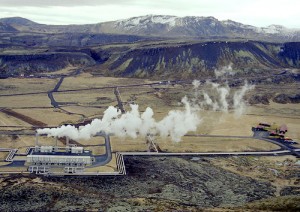
The statement is taken from a federal report on geothermal energy. The document was compiled by a team of 12 scientists led by Stephen Grasby at the federal Geological Survey of Canada and made public on the eve of a conference in Toronto earlier this month.
One of the main advantages of geothermal is that it is available 24 hours, unlike wind and solar, which face intermittency issues.
British Columbia, Alberta, the Yukon and Northwest Territories are the areas where the heat exists closer to the surface, but there are geothermal energy opportunities all over Canada. The researchers estimate that 100 projects would meet the country’s energy needs.
The biggest drawback for geothermal implementation is that upfront costs are very high. The logistics involved are quite daunting: wells must be drilled miles into the earth to bring heat to the surface. And then plants need to be built to turn the heat into electricity. All of this comes with its share of environmental impact, but much less aggressive than the impact caused by fossil fuels.
The report highlights a technique called ‘enhanced geothermal’ as one with great potential. Water or CO2 is injected into the wells so that it can migrate through the cracked rocks to capture heat. The heated water or CO2 is brought back to the surface to produce electricity. Europe and Australia are currently testing this type of hydropower technology.
What do you think? Is geothermal a truly sustainable alternative, and economically viable one as well?
Via Vancouver Sun.
You should follow us here.






What do I think? Geothermal is definitely both sustainable and affordable. Consider for a moment that the largest producer of geothermal is the US (which presumably has similar geology to Canada) and the number two producer of geothermal energy is the Philippines (not the world’s wealthiest nation). As for the “quite daunting” logistics — “wells must be drilled miles into the earth to bring heat to the surface. . . . then plants need to be built to turn the heat into electricity” — that doesn’t sound much different than what we do today to get non-sustainable and non-renewable fuels such as oil (deep wells, tar sands, and expensive refineries) or coal (mining and power plants). Perhaps if geothermal projects were given the same types and amounts of government incentives as coal and oil we would have more of it.
A geothermal energy project in California has been suspended amid fears that it could cause earthquakes in the area. The project, costing million and part of President Obama’s quest to find renewable energy, was run by AltaRock Energy in Middletown, California. Drilling only began in June, but now the company has suspended the project indefinitely, though despite fears from locals about the potential earthquakes and other environmental issues, no exact reason has been given for the project’s suspension.
http://greennews.info/geothermal-energy
Geothermal may “come with its share of environmental impact,” but throughout human history we seem to be incapable of doing anything that doesn’t. Windy’s comment indicates that perhaps it might not be suitable in all parts of the world. Still, geothermal is among the approaches that we should be exploring seriously. The possibility of triggering an earthquake in California duly noted, in most of the world geothermal would be much more sustainable than using coal. The steep initial investment will certainly put a damper on it in today’s economic climate, but the eventual payoff should be much less expensive electricity and, farther down the road, less tax money needed for cleaning up environmental messes.